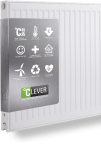- Contents
- Interview with Mikko Iivonen
- It’s time to change our way of thinking
- How insulation influences heating efficiency
- Interview with Professor Christer Harryson
- The increasing use of low temperature water systems
- Interview with Professor Dr. Jarek Kurnitski
- Significant proof
- Choosing a heat emitter
- Interview with Elo Dhaene
- Benefits to the end user

- Insulation > Insulation has always played a major role in keeping homes warm and dry
- The positive impact of changing legislation > Besides saving energy and reducing costs, the immediate benefit of better insulation is a more comfortable indoor climate
- Heat gains and heat losses in modern buildings > When the heat losses and heat gains are all factored in, the effective level of energy efficiency can be determined
- It’s important that the heating system can react quickly to the incidental heat gains
- The smaller the thermal mass of the heat emitter, the better the chances of accurately controlling room temperature
Insulation
Room heat is wasted in two ways: the first is via heat losses Insulation through the building envelope, window, walls, roof etc. to outside (transmission losses); the second is via air flow to outside (ventilation and air leak losses). The purpose of insulation improvements is to minimise transmission losses in the most cost effective way.
A human body emits around 20 l/h CO2 and around 50 g/h of water vapour. In addition, household activities and showering bring several litres of additional water vapour into the room air per day. This makes ventilation air flow essential; reducing it would have dramatic consequences, as it would cause health problems to occupants or contaminate the building (with mould etc).
One issue of improved insulation is the increased airtightness of the building. Poor ventilation, increased room humidity, high CO2 content and construction condensation can all appear as a result. This is why properly insulated buildings should also be equipped with mechanical ventilation.
Insulation has always played a major role in keeping homes warm and dry
The heat recovered from the ventilation air exhaust can then be utilized as an efficient source of energy. Insulation has always played a major role in keeping homes warm and dry, from the earliest use of straw, sawdust and cork. Today’s modern alternatives, such as fibreglass, mineral wool, polystyrene and polyurethane boards and foams, have helped change building methods, encouraging less reliance on the thermal properties of thicker walls and high temperature radiators.
£ 74,000 saved after 20 years
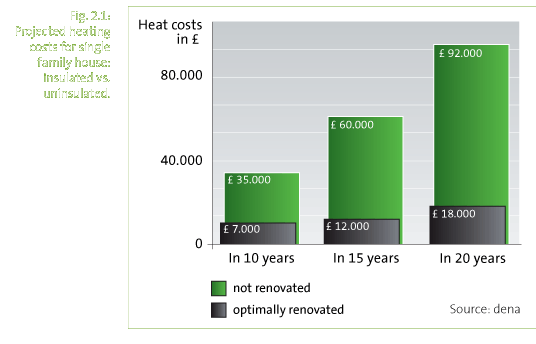

Back in 1977, the norm for design inlet/return was almost double that demanded under EnEV 2009
For homes heated by water-based central heating systems, one of the more remarkable developments shown here is the inlet and return temperatures of the water. Back in 1977, the norm was 90/70 (design inlet/return), almost double that demanded under EnEV 2009. Clearly, this shift towards low water temperature heating systems is made possible by the increasing use of effective energy refurbishment.
The positive impact of changing legislation
Besides saving energy and reducing costs, the immediate benefit of better insulation is a more comfortable indoor climate
Saving energy and reducing costs were not the only effects of tighter regulations. The immediate benefit of better insulation was a more comfortable indoor climate. Figs. 2.3 – 2.5 (overleaf) illustrate a room interior as it would be when insulated in line with changing building legislation. As you can see, the only constant across all examples is the outdoor temperature, a steady -14 °C. The surface temperature of the window in Fig. 2.3 is zero, as the glass is a single pane. In order to reach an acceptable 20 °C room temperature, homes insulated to WSVO 1977 standards had to use hot radiators at 80 °C mean water temperature. Even at this very high temperature, the walls would only reach 12 °C, resulting in a large temperature difference and a range of noticeable cold spots.
Indoor climate
Over time, as building regulations changed, indoor temperatures became noticeably better, as shown in Fig. 2.4. With the widespread use of double glazing came relief from freezing windows and protection from sub-zero temperatures.
To reach ideal room temperature, radiators now had to generate only 50 °C output (average heating temperature), while walls reached 18 °C, a more balanced midpoint between the window’s 14 °C and the air temperature of 20 °C. This situation improves further still for buildings insulated to EnEV 2009 towards EnEV 2012 standards.
The difference between mean surface temperatures in opposite directions varies by no more than 5°C
The walls in Fig. 2.5 are almost at room temperature. Even the windows are warm, despite the freezing exterior. Notice that the radiator output now needs only to reach a mean water temperature of 40 °C to achieve this ideal scenario – 50% less than the same building insulated according to the standards of Fig. 2.3.
* Thermal Comfort: There are several standard criteria; here are some:
- the average value air temperature and mean surface temperature is around 21°C.
- The difference between air temperatures and mean surface temperatures varies by no more than 3°C.
- The difference between mean surface temperatures in opposite direction varies by no more than 5°C.
- The average temperature between head and ankle heights are less than 3°C.
- The air velocity in the room less than 0.15 m/s.
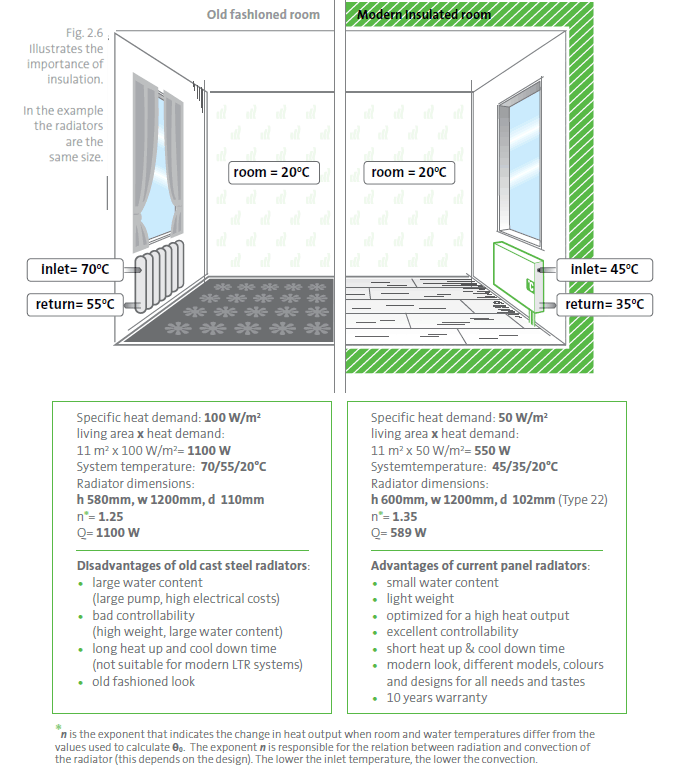
Size of radiators
The increased energy efficiency of buildings during the last 30 years has enabled the design temperatures of radiators to be lowered. In the illustration, both radiators have the same approximate dimensions. The desired room temperature in both cases is the same. As you can see, in an uninsulated house, in order to achieve the desired room temperature, the inlet and return temperatures are much higher than those of a well insulated house. The advantage is that the radiator in the modern room can be the same size as that in the old room, due to the insulation resulting in a lower level of heat demand.
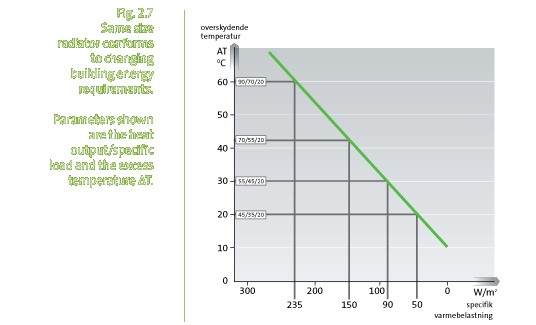
Heat gains and heat losses
The energy needs of a building’s occupants include the demands of their heating system. Fig. 2.8 illustrates of how energy is brought into the home from its starting point, after it is generated as primary energy.
When the heat losses and heat gains are all factored in, the effective level of energy efficiency can be determined
The energy used by a building depends on the requirements of the people inside. To satisfy their needs, and provide a comfortable indoor climate, the heating system has to generate heat from the energy delivered to the building. When the heat losses and heat gains are all factored in, the effective energy can be determined. The way that energy is used depends on the efficiency of the heating system and, as we have seen, on the level of insulation in the building.
Fig. 2.8
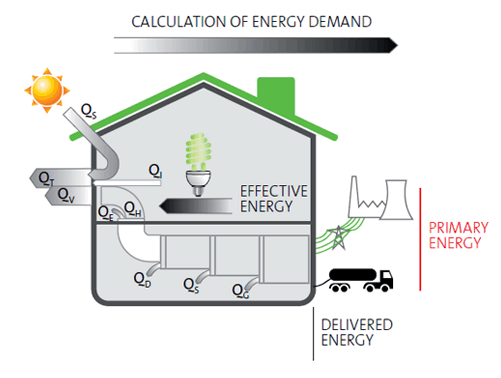
Qt – Transmission heat losses
Qv – Ventilation heat losses
Qs – Solar heat gain
Qi – Internal heat gains
Qe, d, s, g – Losses through emission, distribution, storage and generation
Qh – obciążenie cieplne
Influence of heat gains on modern buildings
Heat gains are often overlooked when discussing effective energy. When electrical equipment is switched on, or additional people enter the building, or sunlight enters a room, these all raise the temperature inside.
Energy efficiency is heavily reliant on two things: how well the heating system can utilize the heat gains and thereby reduce the heating energy consumption; and how low the system heat losses are.
It’s important that the heating system can react quickly to the incidental heat gains
Because modern buildings are more thermosensitive, it is important that the heating system can quickly react to the incidental heat gains. Otherwise, the indoor temperature can soon become uncomfortable for the occupants (which can, for instance, have a negative impact on office productivity).
Fig. 2.9
Thermal heating requirement for a living room of 30 m2. Building standard EnEv 2009, EFH, building location Hanover.
| Thermal load at | -14 °C = 35 W/m2 = 1050 W |
| Thermal load at | 0 °C = 21 W/m2 = 617 W |
| Thermal load at | +3 °C = 18 W/m2 = 525 W |
Average indoor thermal gains
| Average in accordance with DIN 4108-10 | = 5 W/m2x 30m2 = 150 W |
| Person, lying still | = 83 W/person |
| Person, sitting still | = 102 W/person |
| Light bulb, 60 W | = 60 W |
| PC with TFT monitor | = 150 W/unit (active), 15 W/unit (standby) |
| Television (plasma screen) | = 130 W/unit (active), 12 W/unit (standby) |
Example: 2 people, light, TV, etc. = approx. 360 – 460 W
A state-of-the-art heat emission system must be able to adjust quickly to the different thermal gains indoors!





